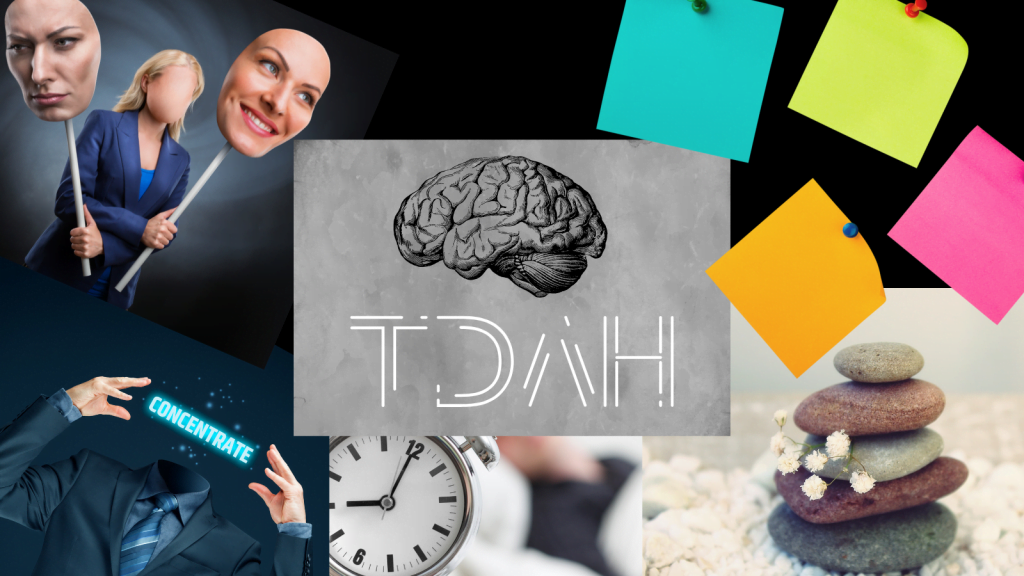Table of Contents
Learn About the Different Subtypes and Find the Best Approach for You

Attention Deficit Hyperactivity Disorder (ADHD) is a neurobiological disorder of complex and multifactorial origin.
Existem três subtipos de Transtorno de Déficit de Atenção e Hiperatividade de acordo com o Manual Diagnóstico e Estatístico de Transtornos Mentais (DSM-5), que é um guia amplamente utilizado para o diagnóstico de transtornos mentais. Esses subtipos são baseados nos sintomas predominantes apresentados pela pessoa com o transtorno. São eles:
- Predominantly Inattentive ADHD: In this subtype, symptoms of inattention are more prominent than symptoms of hyperactivity/impulsivity. People with this subtype may have difficulty maintaining attention, be easily distracted, have trouble organizing tasks, and exhibit frequent forgetfulness.
- Predominantly Hyperactive/Impulsive ADHD: In this subtype, symptoms of hyperactivity and impulsivity are more prevalent than symptoms of inattention. People with this subtype may be excessively restless, have difficulty sitting still, talk excessively, act impulsively without thinking about the consequences, and have difficulty waiting their turn.
- Combined ADHD: This is the most common subtype, in which symptoms of inattention, hyperactivity, and impulsivity are significantly present. People with this subtype may have a combination of symptoms of inattention, such as difficulty concentrating, with symptoms of hyperactivity/impulsivity, such as agitation and impulsiveness in actions.
It is important to note that ADHD is a complex and heterogeneous disorder, and symptom manifestations can vary widely from person to person. In addition, the DSM-5 also introduced a category called “Other Specified” for cases that do not specifically fit into the subtypes mentioned above but still present significant disorder symptoms.
The diagnosis of the ADHD subtype is made based on a clinical evaluation carried out by qualified health professionals, such as psychiatrists, psychologists or neuropediatricians, who take into account the symptoms and the functional impact on the person's daily life.
It affects children, adolescents and adults, and is characterized by the presence of symptoms of inattention, hyperactivity and impulsivity, which can significantly impact the person's daily life and academic, professional and social functioning.
Symptoms of inattention may include difficulty staying focused, being easily distracted, frequently forgetting things, having a tendency to lose things, having difficulty following detailed instructions, and making careless mistakes.
Symptoms of hyperactivity manifest themselves through excessive motor agitation, restlessness, difficulty staying still in situations that require calm, impulsiveness and difficulty waiting for one's turn. In addition, symptoms of impulsiveness can manifest themselves in hasty decision-making, interrupting conversations and difficulty controlling emotional reactions.
The exact cause of ADHD is not yet fully understood, but it is believed that a combination of genetic factors, brain chemical imbalances, and environmental factors may be involved in its development. Research suggests that certain areas of the brain associated with attention control, impulse inhibition, and emotional regulation may exhibit structural and functional differences in people with these disorders.
ADHD is diagnosed by trained health professionals, such as psychologists, psychiatrists or neuropediatricians, through a comprehensive clinical evaluation.
Symptoms must be present in different contexts, such as at home, school or work, and must cause significant impairment in the person's overall functioning. In addition, it is important to rule out other medical or psychiatric conditions that may be contributing to the symptoms.
Treatment for ADHD is individualized and may involve a multimodal approach that includes behavioral interventions, psychoeducational interventions, psychosocial support, parenting, and, in some cases, medication. Behavioral interventions aim to help the person develop strategies to improve organization, planning, impulse control, and attention.
Cognitive behavioral therapy can also be useful in treating ADHD by helping to identify dysfunctional thinking patterns and develop adaptive skills.
In some cases, the use of stimulant medications, such as methylphenidate or amphetamines, may be recommended to control ADHD symptoms. These medications act on the central nervous system, helping to improve attention and reduce hyperactivity and impulsivity. However, the decision to use medication should be made in conjunction with the doctor, considering the benefits and possible side effects.
In addition to treatment, it is important to provide a supportive and understanding environment for people with ADHD. Education, emotional support, time management and organizational strategies, and adaptations in the work or school environment can help maximize the potential of people with ADHD and facilitate their integration into various areas of life.
Although ADHD is a chronic disorder, with proper treatment and support, those affected can learn to manage their symptoms and achieve good functioning in different areas of life. It is essential to seek guidance from specialized health professionals for an accurate diagnosis and an appropriate treatment plan.
Suitable Medications for Treating ADHD

There are different types of medications that can be prescribed as part of the treatment of Attention Deficit Hyperactivity Disorder (ADHD). The most commonly used medications for ADHD are stimulants and the non-stimulants. It is important to emphasize that only a qualified doctor can evaluate and prescribe medications, taking into account the individual characteristics of each person.
- Stimulants:
- Stimulants are the most commonly prescribed medications for the treatment of ADHD. Methylphenidate is a widely used example. It is available in immediate-release formulations, which have a short-lasting effect, and in extended-release formulations, which have a longer-lasting effect throughout the day.
- As anfetaminas, como a dextroanfetamina, também podem ser prescritas para o tratamento do TDAH. Assim como o metilfenidato, elas estão disponíveis em formulações de liberação imediata ou de liberação prolongada.
These stimulant medications help improve attention, reduce hyperactivity, and control impulses in people with ADHD. They work in the central nervous system, affecting neurotransmitters involved in controlling attention and impulsivity. Stimulants are effective for many people with ADHD and often have positive results in reducing symptoms.
However, in some cases, stimulants may not be appropriate or well tolerated. In these cases, doctors may prescribe non-stimulant medications to treat ADHD.
2. Non-Stimulants:
- Atomoxetine, which is a selective norepinephrine reuptake inhibitor. Atomoxetine may be especially helpful for people who do not tolerate stimulants well or have medical conditions that contraindicate its use. Nonstimulant medications also help improve attention and control ADHD symptoms, but they work differently than stimulants. They usually take longer to show full results, but they have the advantage of not being controlled substances and have a different side effect profile.
It is important to highlight that each person responds individually to medications, and drug treatment must be adjusted according to each individual's response and tolerance.
Furthermore, medications should be used in combination with other interventions, such as behavioral therapy, educational support, and adaptive management strategies. Treatment of ADHD is comprehensive and should address medical, psychosocial, and educational aspects.
The decision to use medication and the choice of the most appropriate medication should be made in consultation with a specialist doctor, such as a psychiatrist or a neuropediatrician, who will carefully assess the individual situation and needs of each person with ADHD.
The doctor will consider factors such as age, severity of symptoms, presence of coexisting medical conditions, and history of response to previous medications. The goal is to find the best combination of treatments to help the person effectively manage their symptoms and improve their quality of life.
Tools and applications that help with ADHD

While I can provide general information about tools and apps that can help with ADHD management, it’s important to note that each person is unique and may respond differently to these tools. Additionally, specific app recommendations may depend on factors such as age, individual needs, and personal preferences. Here are a few categories of apps that may be helpful:
- Reminders and Organization:
- Task management apps like Todoist, Trello, or Any.do can help you organize and keep track of your daily tasks.
- Reminder apps like Google Keep, Microsoft To-Do, or Remember The Milk can help you remember important appointments and deadlines.
- Productivity and Concentration Techniques:
- Pomodoro technique apps like Focus Keeper, Forest, or Be Focused can help you break up your time into intervals of focused work interspersed with breaks.
- Distraction-blocking apps like Freedom, Offtime, or Forest can help limit access to apps and websites that might distract you from your tasks.
- Mindfulness and Meditation:
- Meditation apps like Headspace, Calm, or Insight Timer offer guided mindfulness and meditation exercises to help calm the mind and increase mindfulness. We even have an article on our website about mental health and one about the top 1 guided meditation app at the moment, the headspace.
- Logging and Tracking:
- Mood and symptom tracking apps like Daylio, eMoods, or MoodTrack Diary can help you track mood patterns and identify potential triggers.
- Sleep tracking apps like Sleep Cycle, SleepScore, or Sleep Time can help you monitor your sleep quality and identify irregular sleep patterns.
- Mood and symptom tracking apps like Daylio, eMoods, or MoodTrack Diary can help you track mood patterns and identify potential triggers.
It’s important to remember that these suggestions are just examples and may not be right for everyone. Before using any app, it’s a good idea to do your research, read reviews, and seek advice from qualified healthcare professionals who can provide personalized recommendations based on your individual needs.
